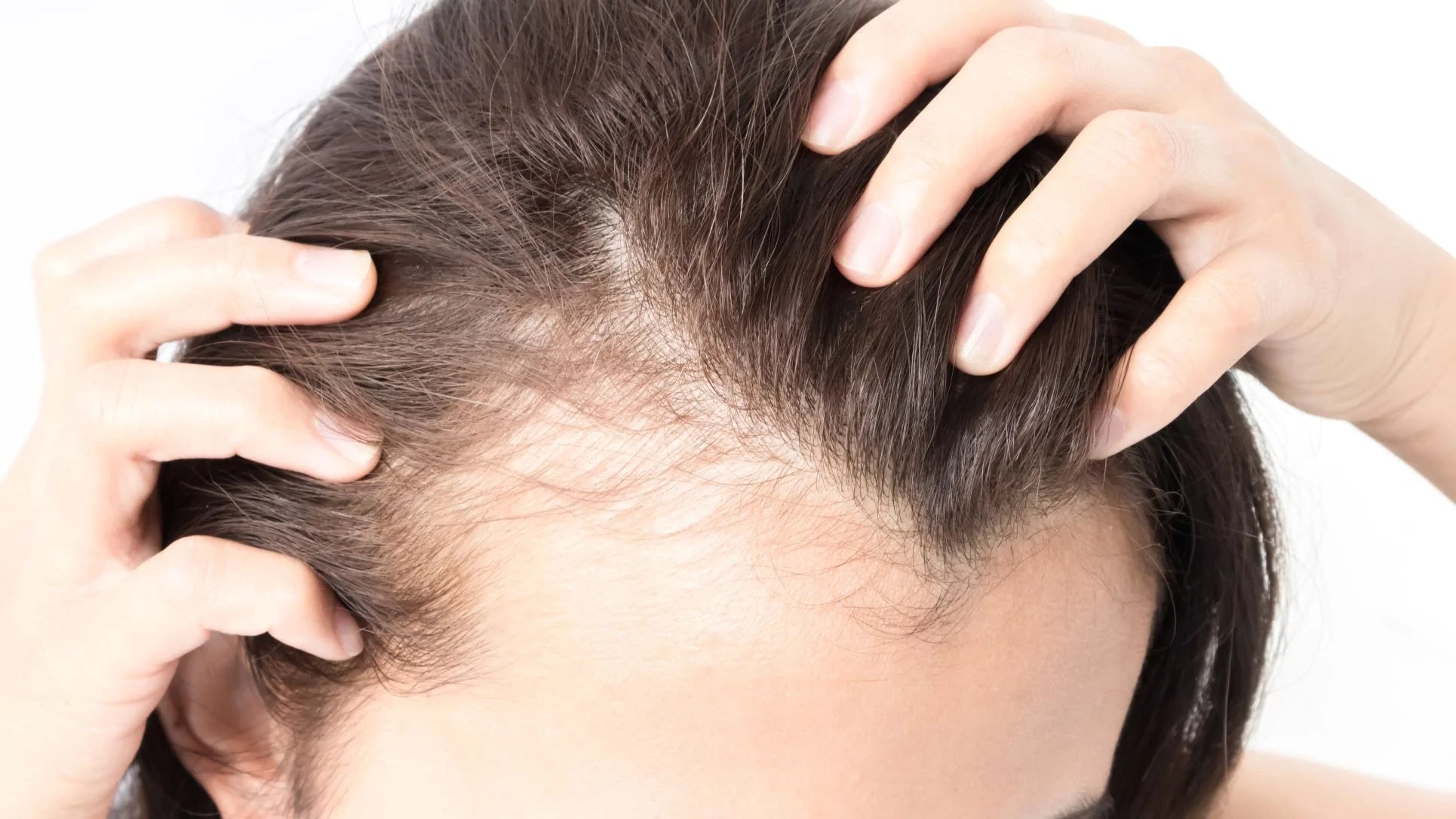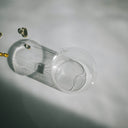Losing hair at the frontal hairline can be a daunting experience for women, as it significantly impacts their self-esteem and appearance.
The hairline frames the face and plays a vital role in expressing one's personal style, making it an essential aspect of our identity.
If you're facing hair loss at the frontal hairline, you're not alone; there is hope for regrowth and restoration.
In this article, we will explore the various causes of hair loss in this area and provide valuable insights on addressing and overcoming this issue.
Embrace the journey towards a healthier, more confident you!
Table of content
What is female hair loss at the frontal hairline?

Female hair loss at the frontal hairline refers to the thinning or shedding of hair in the area where the forehead meets the scalp. This hair loss pattern differs from the more commonly known female pattern hair loss, which typically affects the crown or top of the head. Frontal hairline loss in women can be particularly distressing as it is more noticeable and can impact a person's appearance and self-confidence.
Various factors, such as genetics, hormones, stress, and medical conditions, can contribute to this hair loss.
Understanding the underlying causes is the first step toward finding appropriate solutions and treatments to restore and maintain a healthy frontal hairline.
As your leading source for hair health information over the past 4 years, we never compromise on accuracy. When it comes to your health, you deserve information you can truly rely on - and earning your trust is our top priority.
Here's how Scandinavian Biolabs ensures every piece of content meets the highest standards of accuracy and integrity:
- Credentialed Experts: Our reviewers are actively practicing doctors and medical researchers
- Stringent Reviews: Content undergoes rigorous editing by subject specialists and review by a practicing doctor.
- Evidence-Based: We rely on well-established research from trusted scientific sources like peer-reviewed journals and health authorities.
- Full Transparency: Our editorial standards, writer credentials, reviewer credentials, correction process, and funding are all publicly documented.
- Independent Voice: While we do promote products, we operate in a vacuum to business operations. Our main goal is just an unwavering commitment to providing medically-sound guidance.
You can count on Scandinavian Biolabs to consistently deliver the trustworthy health information you deserve. Read our Editorial Standards.
What can cause hair loss at the frontal hairline?
Various factors contribute to hair loss at the frontal hairline, including genetics, hormones, stress, and medical conditions. We will discuss some of the most common causes in detail below.
Androgenetic Alopecia
Androgenetic Alopecia is the most common form of hair loss in men and women. A combination of genetics, hormones, and aging causes it.
In women, it presents as diffuse thinning over the entire scalp, with noticeable loss along the frontal and temporal hairline.
Some women may experience more localized loss confined to the frontal hairline.
Telogen Effluvium
Telogen Effluvium is a temporary hair loss condition typically triggered by a stressful event, whether psychological or physical.
The stressor causes the body to shift a disproportionate amount of hair from the growth phase into the resting phase.
After about three months in the resting phase, the resting hairs are shed, and the hair loss becomes visible.
While the excessive hair loss caused by Telogen Effluvium typically happens throughout the scalp, the frontal hairline may also be impacted.
Fortunately, this hair loss is not permanent and usually resolves independently.
Frontal Fibrosing Alopecia
Frontal Fibrosing Alopecia is a specific condition affecting the frontal part of the scalp, where inflammation and scarring lead to permanent hair loss in the area.
It is part of a group of hair loss conditions called "scarring alopecia." With this condition, the frontal hairline slowly recedes, and eyebrows are commonly affected.
Frontal Fibrosing Alopecia is considered a variation of an inflammatory skin condition called lichen planopilaris, which most often affects postmenopausal women.
The exact causes of both conditions are unknown, but research indicates that hormonal changes, autoimmune diseases, and environmental factors might play a role.
Trichotillomania
Trichotillomania, a hair-pulling disorder, is a condition where people compulsively pull out their hair and find it difficult to stop.
If the frontal hairline is pulled, it could result in bald patches or general thinning in the area. Most often, if the hair pulling is treated, the affected areas can return to regular hair growth.
However, if the pulling is chronic and lasts long, the follicles may be permanently damaged.
Traction Alopecia
Traction Alopecia is a hair loss condition that can affect the frontal hairline due to repeated stress on the hair follicles from hair styling practices or tight hairstyles.
Tight ponytails or braids that pull hair with a lot of force wear on the follicles over time, and eventually, the affected follicles stop growing hair.
Because tight hairstyles often pull on the temporal parts of the scalp, the frontal hairline may be impacted first.
Early diagnosis and treatment of Traction Alopecia can reverse hair loss, but late-stage cases can lead to permanent hair loss.
Other Medical Conditions
- Thyroid issues: Hypothyroidism and Hashimoto's can lead to hair loss or thinning at the frontal hairline
- Autoimmune conditions: Lupus and other autoimmune diseases can cause hair loss in the frontal scalp area
- Nutritional deficiencies: Lack of iron, biotin, zinc, and selenium can contribute to hair loss at the frontal hairline
- Type 2 diabetes: This can result in hair loss due to blood vessel damage that affects hair follicle nourishment.
How to treat female hair loss at the frontal hairline?
Treating female hair loss at the frontal hairline involves identifying the underlying cause and selecting the most appropriate treatment method. This section will discuss various treatment options and their effectiveness in addressing hair loss in the frontal hairline.
1. Scandinavian Biolabs Hair Growth Routine

Scandinavian Biolabs offers a 3-step hair growth routine designed to help reduce hair loss, encourage new hair growth, and maintain strong, vital hair.
The routine includes a Bio-Pilixin serum, conditioner, and shampoo, all containing multiple plant-based growth factors developed using stem cell technology to nourish hair follicles and promote growth.
Clinical trials have demonstrated positive results, with 97% of users experiencing reduced hair loss and 73% reporting increased hair density.
The Bio-Pilixin formula provides essential nutrients to derma papillae cells, crucial for hair growth during the anagen phase.
It also stabilizes blood flow to the scalp, ensuring consistent delivery of nutrients, oxygen, and growth factors to hair follicles.
This process helps to shorten the telogen (shedding) phase and stimulate more rapid hair growth.
Formulated with effective, vegan ingredients inspired by nature, the Scandinavian Biolabs Hair Growth Routine is a promising option for those experiencing hair loss at the frontal hairline.
2. Minoxidil
Minoxidil is a topical medication approved by the FDA for treating hair loss in both men and women.
It stimulates hair follicles and promotes blood flow to the affected area, encouraging hair growth. Minoxidil has been proven effective in treating female pattern hair loss, including hair loss along the frontal hairline.
It is generally applied twice daily and may take several months to show visible results.
Read this: 16 Potential Side Effects Of Minoxidil For Women
3. Finasteride
Finasteride is an oral medication primarily prescribed for male pattern baldness but has shown some effectiveness in treating female pattern hair loss, particularly in postmenopausal women.
It blocks the conversion of testosterone to dihydrotestosterone (DHT), a hormone responsible for hair follicle shrinkage and loss.
However, finasteride is not recommended for women of childbearing age due to its potential side effects and the risk of birth defects.
Read this: 6 Most Effective Alternatives To Finasteride
4. Micropigmentation
Micropigmentation, also known as scalp micro pigmentation, is a cosmetic procedure that uses tiny, colored pigments to create the appearance of hair follicles on the scalp.
This can help to create the illusion of a fuller hairline and is particularly suitable for those with permanent hair loss, including frontal fibrosing alopecia.
Micropigmentation is a non-surgical procedure and can be a viable option for women looking for a less invasive solution to hair loss at the frontal hairline.
5. Maintain a balanced diet

A balanced diet of essential vitamins and minerals is crucial for maintaining healthy hair growth.
Ensuring adequate intake of nutrients such as iron, biotin, zinc, and selenium can help to support hair growth and potentially slow down hair loss at the frontal hairline.
7. Be gentle with your hair
Avoiding tight hairstyles, excessive heat styling, and harsh chemical treatments can help prevent traction alopecia and further hair damage.
Opt for looser hairstyles and gentle hair care products to reduce stress on hair follicles and minimize hair loss at the frontal hairline.
8. Manage stress
Chronic stress can contribute to hair loss conditions like telogen effluvium.
Incorporating stress management techniques such as meditation, yoga, and regular exercise into your daily routine can help improve overall well-being and potentially reduce hair loss at the frontal hairline.
Read this: 9 Effective Methods How To Regain Hair Loss From Stress
9. Hair transplantation
Hair transplantation is a surgical procedure that involves removing hair follicles from a donor site, usually at the back or sides of the head, and transplanting them to the area affected by hair loss, such as the frontal hairline.
This method can be highly effective in treating female hair loss at the frontal hairline, especially when other treatments have not provided satisfactory results.
It is important to note that hair transplantation may not be suitable for all types of hair loss, and it's essential to consult a qualified medical professional to determine if this treatment option is appropriate for your specific situation.
Read this: The 12 Best Natural and Drug Hair Transplant Alternatives
Importance of early diagnosis for female hair loss at the frontal hairline
The importance of early diagnosis for female hair loss at the frontal hairline cannot be overstated. Identifying and addressing hair loss in its initial stages increases the likelihood of successful treatment and better outcomes.
Early diagnosis allows for prompt intervention, which can help slow down the progression of hair loss and, in some cases, even reverse it.
Furthermore, early detection makes it easier to pinpoint the underlying cause, whether it be hormonal imbalances, medical conditions, or lifestyle factors, and tailor the most effective treatment plan accordingly.
Additionally, addressing hair loss at the onset can help alleviate the emotional and psychological impact on women, promoting a positive self-image and overall well-being.
To ensure timely diagnosis, it is crucial to monitor changes in hair density, texture, and hairline and consult a healthcare professional or hair specialist if any concerns arise.
Hair care tips to prevent female hair loss at the frontal hairline

Taking proactive measures to maintain healthy hair can help prevent female hair loss at the frontal hairline. Here are some hair care tips to keep in mind:
- Limit heat styling: Minimize the use of heat styling tools like flat irons, curling irons, and blow dryers, which can weaken hair and lead to breakage.
- Choose loose hairstyles: Opt for loose, low-tension hairstyles to avoid excessively stressing hair follicles.
- Use gentle products: Select hair care products free of harsh chemicals and sulfates, which can strip hair of natural oils and contribute to hair loss.
- Scalp care: Keep your scalp clean and moisturized using products specifically designed for your hair type and scalp condition.
- Regular trims: Get regular hair trims to minimize split ends and maintain hair health.
- Protect from the sun: Use a hat or hair products with UV protection to shield your hair from the sun's harmful rays, which can damage hair and contribute to hair loss.
Incorporating these hair care tips into your daily routine can help prevent hair loss at the frontal hairline and maintain healthier, stronger hair.
Conclusion
Female hair loss at the frontal hairline can be a challenging and emotional experience for those affected.
However, by understanding the various causes and seeking an early diagnosis, you can take control of your hair's health and explore appropriate treatment options.
By incorporating the hair care tips in this article, you can proactively maintain your hair's health and minimize the risk of hair loss.
Always consult a healthcare professional or hair specialist to determine the best course of action for your specific situation.
Remember, you are not alone in this journey, and with the right approach, you can regain your confidence and embrace your unique beauty.
FAQs
Can female hair loss at the frontal hairline be reversed?
Depending on the underlying cause, hair loss at the frontal hairline can often be reversed or slowed down with early intervention and appropriate treatments, such as the Scandinavian Biolabs Hair Growth Routine, Minoxidil, or lifestyle changes. However, some conditions, like frontal fibrosing alopecia, may result in permanent hair loss.
Is hair loss at the frontal hairline in women hereditary?
Genetics can play a role in hair loss at the frontal hairline, particularly in cases of androgenetic alopecia. However, several other factors, such as hormones, stress, and medical conditions, can also contribute to hair loss in this area.
How long does it take to see results from hair loss treatments?
The time it takes to see results can vary depending on the treatment and the individual's response. For example, Minoxidil may take several months to show visible results. In contrast, the Scandinavian Biolabs Hair Growth Routine has shown improved hair density and reduced hair loss within 150 days in clinical trials.
How can I prevent hair loss at the frontal hairline?
Preventative measures include maintaining a balanced diet, avoiding tight hairstyles, limiting heat styling, using gentle hair care products, managing stress, and protecting your hair from the sun. Following these tips can help maintain healthy hair and potentially prevent hair loss at the frontal hairline.
References:
- https://www.ncbi.nlm.nih.gov/pmc/articles/PMC6691938/
- https://www.ncbi.nlm.nih.gov/pmc/articles/PMC6322157/
- https://www.cureus.com/articles/32514-telogen-effluvium-a-review-of-the-literature#!/
- https://www.ncbi.nlm.nih.gov/pmc/articles/PMC7320655/
Read more:





